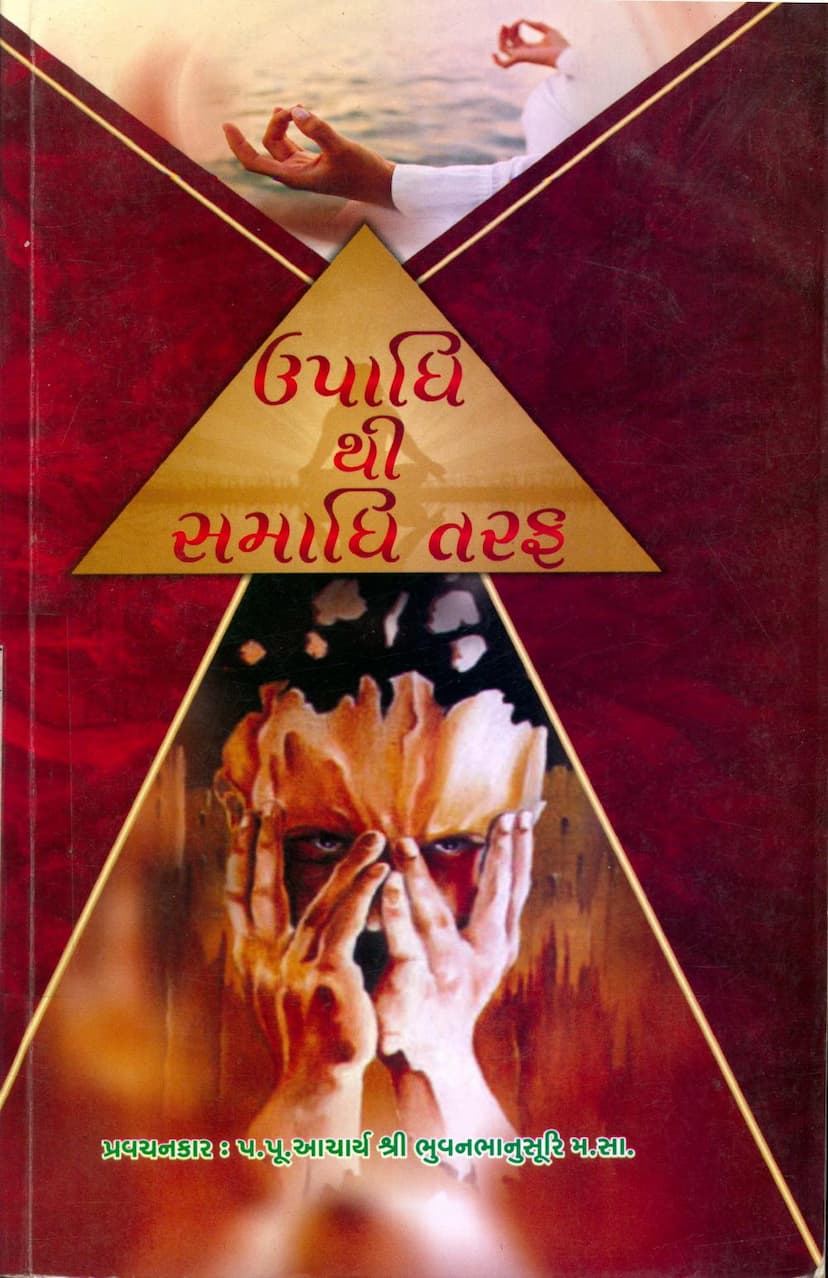Upadhithi Samadhi Taraf
Added to library: September 2, 2025

Summary
Here's a comprehensive summary of the Jain text "Upadhithi Samadhi Taraf" by Bhuvanbhanusuri, based on the provided pages:
Core Theme: The book, "Upadhithi Samadhi Taraf" (Moving from Suffering to Peace/Salvation), authored by Acarya Bhuvanbhanusuri, aims to guide individuals from the suffering and afflictions of worldly attachments and anxieties (upadhi) towards inner peace and spiritual liberation (samadhi).
Central Argument: The fundamental message is that the cycle of suffering in the world (samsara) is caused by the "three types of heat" or afflictions: Adhi (mental distress), Vyadhi (physical illness), and Upadhi (worldly attachments and dependencies). The text strongly advocates that the only true path to lasting peace and liberation from these afflictions is through the Ratnatrayi (Three Jewels): Samyagdarshan (Right Faith), Samyagjnan (Right Knowledge), and Samyagcharitra (Right Conduct).
Detailed Breakdown of Key Concepts:
-
The Threefold Suffering (Adhi, Vyadhi, Upadhi):
- Adhi (Mental Distress): This is described as mental anguish, constant worry, anxieties, obsessive thoughts, and even finding contentment in material possessions, which ultimately leads to mental suffering. It's likened to a subtle poison that doesn't immediately reveal its harmful effects.
- Vyadhi (Physical Illness): This refers to physical ailments and the discomfort they bring. The text points out how modern lifestyles and sometimes even the pursuit of health through medicine can paradoxically lead to more illnesses or the perception of them.
- Upadhi (Worldly Attachments/Dependencies): This is presented as the root cause or at least a major facilitator of Adhi. Upadhi encompasses everything from wealth, possessions, family, status, to even one's own body. These attachments create dependencies and lead to mental turmoil (Adhi). Owning a car, for instance, is an upadhi that brings numerous anxieties (driver's dependence, fuel, maintenance, social pressures, etc.). The more upadhis one has, the greater the potential for Adhi.
-
The Ratnatrayi as the Solution: The text repeatedly emphasizes that the only genuine remedy for these three afflictions is the consistent and dedicated practice of Right Faith, Right Knowledge, and Right Conduct. This practice involves their veneration, protection, growth, purification, and appreciation.
-
Critique of Worldly Pursuits:
- Attachments (Upadhi): The book is critical of the incessant desire for material wealth, possessions, and sensory pleasures. It argues that these are ultimately the sources of suffering and do not bring true happiness. Examples like the desire for a big house, possessions, or even social status are shown to be breeding grounds for anxiety and dissatisfaction.
- Ambition and Stubbornness (Chadas and Mamata): Unbridled ambition and stubborn adherence to one's opinions (mamata) are identified as major obstacles. Stories like that of Ravana and Sumali Chakravarti illustrate how these traits lead to destruction. The text differentiates between positive aspirations (like striving for virtue) and unhealthy ambition driven by ego and desire.
- The Illusion of Happiness in Worldly Things: The text challenges the notion that external things bring happiness, asserting that happiness is an internal experience. It uses examples of wealthy individuals suffering from anxiety (like "Mammam") and contrasting them with individuals with fewer material possessions but inner peace (like Punia Shravak).
-
The Role of Karma and Foresight:
- Omens (Apshakun): The text discusses the connection between omens and karma. While omens might not directly cause bad karma, they are seen as indicators of impending negative karmic influences. This suggests a need for caution and awareness.
- Karma and Effort (Purushartha): The text acknowledges the reality of karma but also stresses the importance of human effort (purushartha). It suggests that diligent effort, when aligned with right principles, can mitigate or overcome negative karmic effects. However, it cautions against the pride in effort that ignores the role of karma or divine guidance.
- Understanding Karma: The text delves into the mechanisms of karma, explaining how good or bad intentions (adhyavasa) influence karmic bondage and fruition. It highlights the power of positive mental states in mitigating negative karma and enhancing positive karma.
-
Key Virtues and Practices:
- Purity (Pavitrata): Maintaining purity in one's actions, thoughts, and speech is presented as a foundational virtue.
- Humility and Reverence (Vinay): Humility towards elders, spiritual guides, and the teachings is essential.
- Service (Seva): The importance of selfless service to others is stressed.
- Self-Reliance vs. Dependence: The text subtly encourages self-reliance while acknowledging the need for spiritual guidance.
- Detachment: The ultimate goal is to cultivate detachment from worldly things, recognizing their impermanent nature.
-
The Importance of Discrimination (Vivek): The ability to discern the essential from the non-essential (asara vs. sara) is crucial. This involves understanding what truly benefits the soul and what is merely a fleeting worldly attraction.
-
Illustrative Stories and Examples: The text uses narratives like the story of the merchant's son Chandra, Ravana, Bahubali, and others to illustrate the consequences of various actions, attachments, and the power of virtuous living. The story of Chandra's misguided ambition and subsequent despair, his attempts at suicide, and his eventual guidance by a Muni serves as a central cautionary tale. The story of the minister and his wife Saraswati highlights the complexities of attachment and the importance of understanding the true nature of relationships.
-
The Path to Samadhi: The ultimate aim is "Samadhi," which signifies a state of mental stillness, peace, and absorption in the Self, leading to liberation. This state is attainable through the diligent practice of the Ratnatrayi and the gradual shedding of upadhis.
Overall Message: "Upadhithi Samadhi Taraf" is a profound spiritual guide that dissects the nature of worldly suffering and offers the timeless Jain path of Right Faith, Knowledge, and Conduct as the sole means to achieve lasting peace and spiritual well-being. It encourages introspection, detachment from worldly entanglements, and the cultivation of virtues to navigate life's challenges and attain the ultimate goal of liberation.